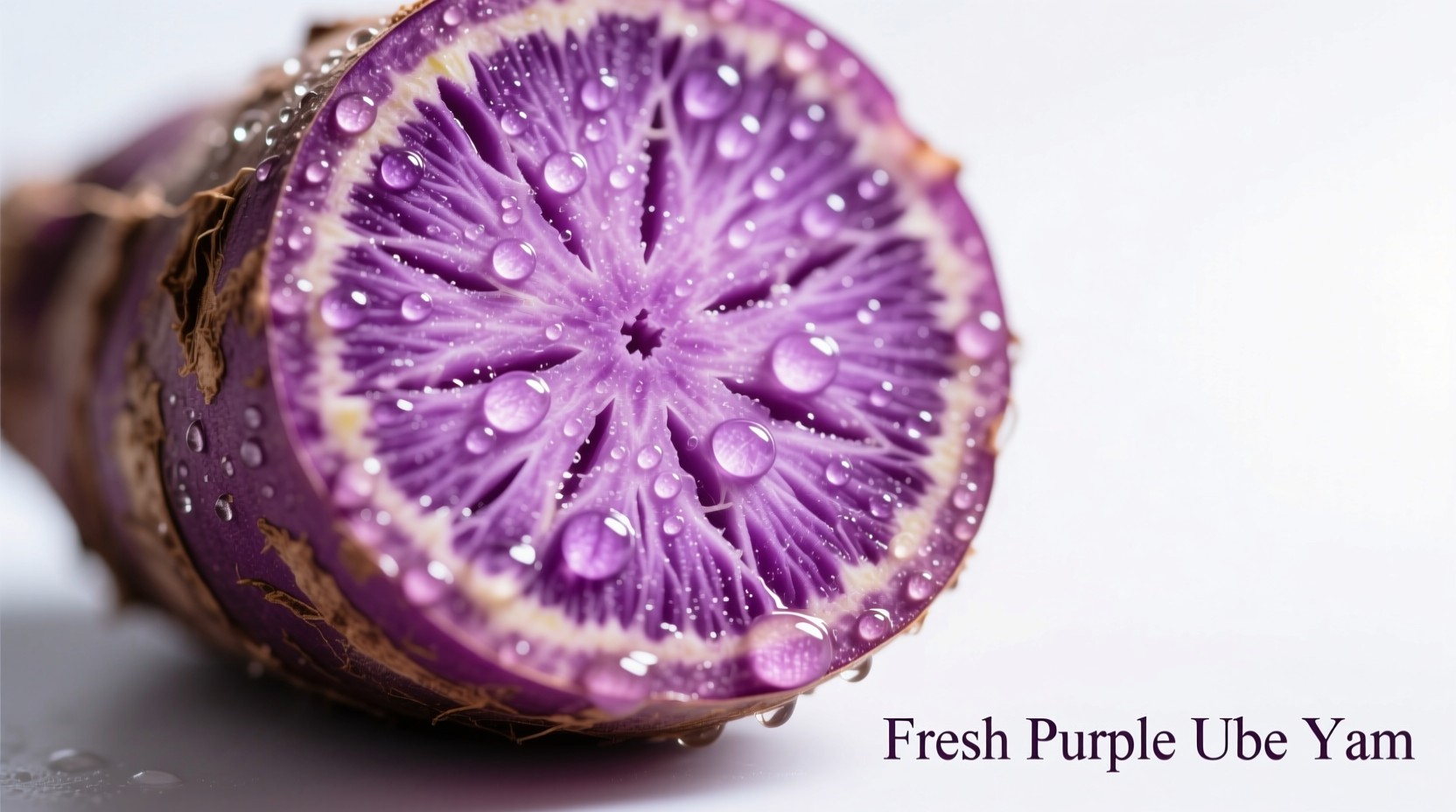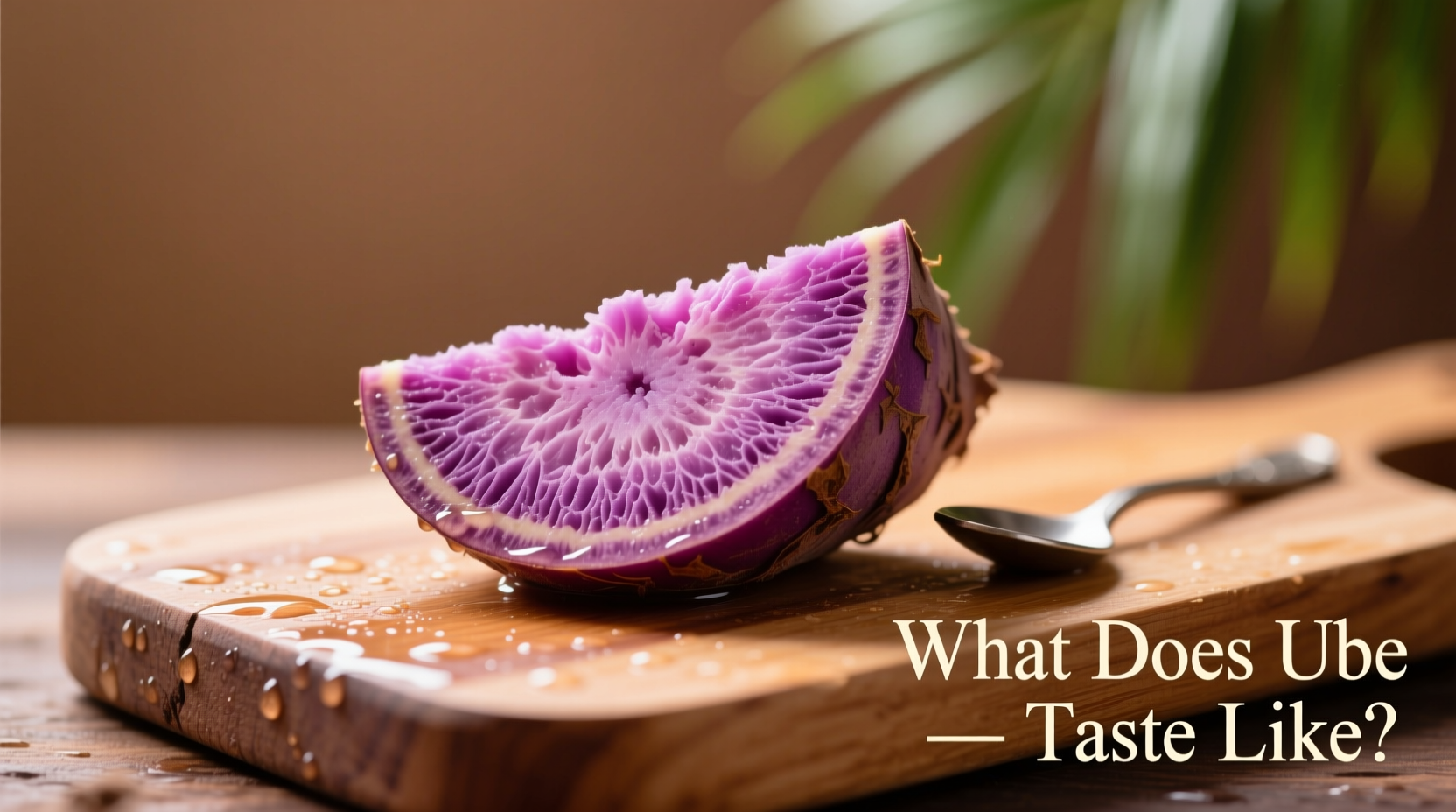Curious about the distinctive taste of ube? This vibrant purple tuber has taken foodie circles by storm, appearing in everything from artisanal ice creams to trendy lattes. But what does ube taste like in reality, beyond the social media hype? Forget artificial purple coloring and synthetic flavors—real ube offers a nuanced flavor experience that's both comforting and intriguingly complex.
Your First Bite: The Immediate Sensory Experience
When you first taste properly prepared ube, you'll notice a gentle sweetness that's never cloying. Unlike orange sweet potatoes that hit you with intense sugar notes, ube's sweetness is subtle and well-balanced. The earthy foundation reminds you this is a root vegetable, but it's elevated by delicate nutty undertones that dance across your palate. Many culinary experts describe a whisper of vanilla that emerges as you chew—a characteristic that makes ube particularly magical in desserts.
Deconstructing the Flavor Profile
Ube's flavor complexity comes from several distinct elements working in harmony:
- Sweetness level: Moderate natural sugars (about 15% less sweet than orange sweet potatoes)
- Earthy notes: Distinct soil-like undertones that ground the sweetness
- Nutty dimension: Similar to fresh chestnuts or young coconut
- Floral hint: That elusive vanilla-like quality that intensifies with cooking
- Aftertaste: Clean and refreshing without lingering heaviness
Food scientists at the University of the Philippines Food Science Institute have identified specific compounds in ube (Dioscorea alata) that contribute to this unique profile. The tuber contains natural vanillin precursors that develop during cooking, explaining those beloved vanilla-like notes without any actual vanilla being added.
| Characteristic | Ube (Purple Yam) | Purple Sweet Potato | Taro |
|---|---|---|---|
| Sweetness | Moderate, balanced | High, pronounced | Mild, subtle |
| Earthy Notes | Pronounced but refined | Mild | Strong, sometimes bitter |
| Distinctive Flavor | Vanilla/nutty hints | Caramel-like | Nutty with grassy notes |
| Texture When Cooked | Creamy, smooth | Dense, moist | Starchy, sometimes grainy |
| Color Stability | Holds vibrant purple | Fades to muted purple | Grayish when cooked |
How Preparation Transforms Ube's Flavor
The way you prepare ube dramatically affects its final taste profile. When raw, ube has a somewhat bland, slightly bitter quality. But cooking unlocks its magic:
Steaming or boiling: Preserves the delicate floral notes while developing natural sweetness. This method yields the purest ube flavor, perfect for traditional Filipino ube halaya (jam).
Roasting: Concentrates sugars and enhances nutty characteristics. Professional chefs often roast ube before incorporating it into desserts for deeper flavor complexity.
With coconut milk: A classic Filipino preparation where the subtle sweetness of coconut complements ube's earthiness without overwhelming it. The fats in coconut milk help carry ube's flavor compounds, making the taste more pronounced.
According to culinary research published in the Journal of Ethnic Foods, adding a pinch of salt during cooking significantly enhances ube's natural sweetness through flavor contrast—a technique traditional Filipino cooks have used for generations.
Real Ube vs. Artificial Flavor: What You're Actually Tasting
Here's where things get tricky in today's ube-crazed market. Most commercial "ube" products—especially outside Southeast Asia—rely on artificial flavoring combined with purple food coloring. Real ube has a much more nuanced profile than the one-dimensional sweetness of artificial versions.
True ube flavor features:
- Natural variation depending on growing conditions
- Subtle earthiness that artificial versions lack
- Complex sweetness that builds gradually
- Noticeable but not overwhelming floral notes
If you've only tried artificially flavored ube desserts, you haven't experienced the real thing. Authentic ube products will list "purple yam" or "Dioscorea alata" as the primary ingredient, not "ube flavor" or artificial coloring.
When Ube Shines (and When It Doesn't)
Understanding ube's flavor limitations is crucial for culinary success. While incredibly versatile, ube has specific contexts where it performs best:
Ideal applications:
- Desserts where subtle sweetness is preferred over intense sugar
- Cold preparations like ice cream that highlight its floral notes
- Dishes where vibrant natural coloring is desired
- Recipes that benefit from creamy texture without heavy starch
Less successful applications:
- High-heat cooking that destroys delicate flavor compounds
- Savory dishes requiring strong umami (though some Filipino stews use it)
- Recipes needing intense sweetness without additional sugar
- Long-cooked dishes where its flavor gets overwhelmed
Food anthropologists note that in traditional Filipino cuisine, ube rarely appears in purely savory applications. Its natural sweetness makes it predominantly a dessert ingredient, though modern fusion chefs are experimenting with innovative savory uses.
Bringing Ube Into Your Kitchen: Practical Tips
Ready to experience authentic ube flavor? Here's what you need to know:
Selecting quality ube: Look for firm tubers with smooth skin and minimal blemishes. The deepest purple varieties typically offer the most vibrant color and pronounced flavor. Avoid any with soft spots or mold.
Storage secrets: Store unpeeled ube in a cool, dark place for up to three weeks. Once peeled, submerge in water and refrigerate for no more than three days to prevent oxidation.
Preparation pro tip: Steam rather than boil to preserve flavor compounds. After cooking, mash while still warm for the smoothest texture—this is why authentic ube ice cream has that distinctive creamy mouthfeel without being grainy.

For those outside tropical growing regions, frozen ube puree often provides better flavor than imported fresh tubers that have traveled long distances. The University of Hawaii's College of Tropical Agriculture recommends freezing ube within 24 hours of harvest to preserve maximum flavor compounds.
The Cultural Journey of Ube's Flavor
Ube's distinctive taste profile has deep cultural roots. Originating in Southeast Asia, this purple yam became central to Filipino cuisine through centuries of agricultural development. Traditional preparation methods—like slow-cooking ube with coconut milk and sugar to create ube halaya—were designed specifically to enhance its natural flavor characteristics.
As Filipino communities spread globally, they brought their ube traditions with them. What was once a regional specialty has evolved into an international phenomenon, though the authentic flavor experience remains distinct from commercialized versions. Food historians note that pre-colonial Filipinos valued ube for both its nutritional properties and distinctive color, which carried cultural significance in traditional ceremonies.
Final Flavor Thoughts
So what does ube taste like? Imagine the gentle sweetness of a young sweet potato blended with the earthiness of roasted chestnuts and a whisper of natural vanilla—all wrapped in a vibrant purple package. It's a flavor experience that's simultaneously familiar and intriguingly unique. When prepared authentically, ube offers a sophisticated taste profile that's earned its place as more than just a colorful food trend.











 浙公网安备
33010002000092号
浙公网安备
33010002000092号 浙B2-20120091-4
浙B2-20120091-4